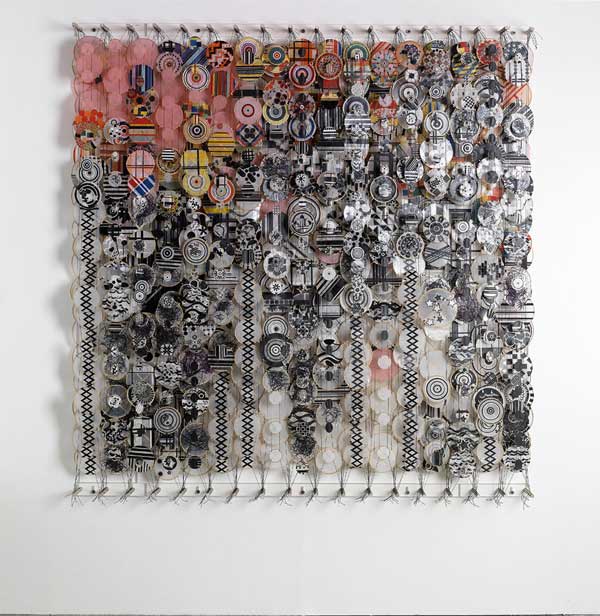-
Eclectic Armory
by Jessica Loudis March 8, 2010

If the general consensus about the Whitney Biennial is that the show was guardedly conservative, then the 2010 Armory is further evidence that galleries are a step ahead of museums in taking the irregular pulse of the art world. After a 2009 Armory that saw exhibitors play it safe (many galleries stuck to painting or name-brand artists), this year’s show was marked by playfulness and experimentation, as well as a palpable sense of relief about the fact that yes, people were going to buy things.
One of this year’s most striking trends was the prominence of large-scale multimedia sculpture. The Armory daze—a naturally occurring condition induced by the attempt to synthesize thousands of artworks in a matter of hours—was routinely broken by encounters with a nude, bronzed leather daddy (Marc Quinn), a feathered and cast iron Scrooge McDuck (Sven’tJolle), or a taxidermied cow mounted atop a lion, hawk, and peacock (the Joachim Schonfeldt gallery). While work from Berlin, the year’s featured player, was elegant but muted, Parisian galleries were especially adventurous, and the Nathalie Obadia, Emmanuel Perrotin and Loevenbruck galleries all revealed a common bent towards the bizarre and arresting. At Perrotin, Daniel Firman’s Grey Matters translates Japanese video game Katamari Damancy into sculptural form (the top half of a mannequin is obscured by a heap of gray trash); and at Loevenbruck, the repetitive patterns of Lang/Baumann’s sprawling aluminum sculptures bridge the divide between the architectural and the painterly.
Among these, a personal favorite was John Reynold’s 1001 Nights, a DIY-style staircase whose 1,001 cardboard cubes featured lines from the Scheherazade collection on one side, and excerpts from Robert Fisk’s “The Great War for Civilisation” on the other. (One block read “The land of the Persians” on one side, and “The Green Zone” on the other). In an inadvertent act of irony, the piece was only several booths away from Reed Seifer’s Spray to Forget: a performance-cum-design project that hawked “a beneficial editor for one’s consciousness” at the unbeatable price of $25 a bottle. Surprisingly, Spray to Forget wasn’t the exhibition’s lone conceptual work, either: at Cape Town’s Michael Stevenson gallery, free manicures were offered to anybody in need; and later in the afternoon, a small brass band took up residency next to the aforementioned cow.
While multimedia work generally set the tone, the renewed sense of creative freedom was also apparent in painting. New York’s Ronald Feldman gallery dedicated several walls to Nancy Chunn’s R. Crumb-esque canvases; Paul Kasmin turned its space over to James Nares’ deconstructive brush work, and Verona’s Studio la Citta featured a number of Jacob Hashimoto’s three-dimensional canvases; elaborately constructed pieces that assemble fragments of rice paper into overlapping geometric patterns. But if painting was downscaled this year, photography seemed to almost vanish entirely. Hiroyuki Masuyama’s eerie photomontages were also on display at Studio la Citta—The Burning of the House of Parliament, 1839 compiled a Turner-inspired vision of London through over 300 photos—but all in all, photography took a backseat to bigger, weirder works.
As the New York Times rightly points out, overtly socio-political art was also cheerfully omitted this year, and the little art that did grapple with politics did so in a veiled manner. Adam McEwen’s I am Curious (Yellow) dances around questions of fascism and gender norms through oversized yellow swastikas and Caster Semenya obituaries (as well as its referential title) but in general, the collection was more visually striking than ideologically forceful. No matter. What the Armory lacks in critique it makes up for eclecticism and entertainment value, and at least until the art world gets completely back on its feet, that may not a bad thing.

